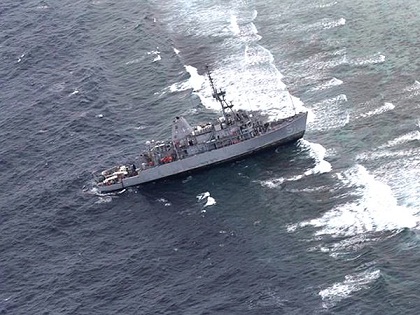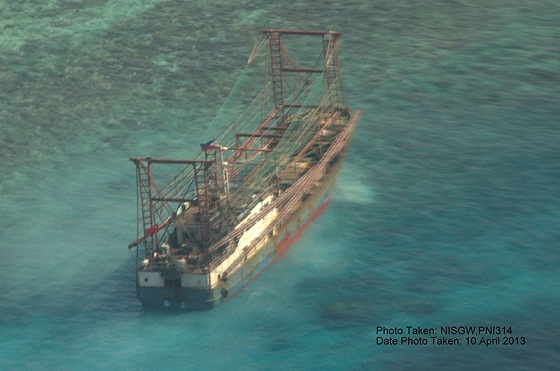
By Rex Robles,VERA Files
It was 1974 and I was taking up an advanced course in Mechanical Engineering at the US Navy Postgraduate School in Monterey, California. For our final exam in Oceanography, our professor simply called the twelve of us to his office one by one and asked us a few questions. I noticed a certain level of interest in the Philippines that I did not expect.
For instance, he showed me a satellite photograph of Manila Bay and asked me what I thought about a plan to build a highway along the Manila-Cavite coastline. I mumbled some comment on how the ecology in the area would be affected.
Then he showed me photographs of the entire Sulu Sea with what looked like ridgelines in the water running roughly parallel to Palawan. I was intrigued. My professor, who is based in New Zealand, told me they were a dozen or so swells that go northwest at certain times. At other times, they go the opposite way.
The swells seemed to emanate from the Tubbataha area. I could find no natural explanation for the phenomenon and neither, it appeared, could my professor. We talked about Tubbataha having been formed from underwater volcanoes, about the effect of winds and tides, but arrived at nothing conclusive. Could the swells have come from seismic tests, as in oil exploration? But then the swells would hardly appear linear as captured by the satellite images. And they would go only one way.
The special interest in the Philippines and its underwater resources seemed even more pronounced during a class visit to Port Hueneme in California, where the US Navy ran a facility for testing certain projects, most of them top secret. As a foreign student, I was not allowed to enter the area where Polar environments were simulated, but instead was brought to a huge, air-conditioned warehouse where they kept soil samples extracted from the ocean bottom by their research vessels.
I was shown soil samples taken from the South China Sea by a government vessel, the Glomar Challenger I. At that time, the United Nations Commission on the Law of the Sea or UNCLOS was still unheard of and my hosts presumably saw nothing wrong with taking samples from what they considered then as international waters. It was surmised at that time, from the samples analyzed, that the area was rich in carbon deposits, both gas and oil.
A young US Coast Guard Officer formally opined in a term paper he submitted to our class in Maritime Law that the waters around Tubbataha were international in character, following the 12 km limit for internal waters being observed at the time. I felt compelled to submit a rebuttal pointing out that among other cases, wide portions of Hudson Bay in North America would have to be treated likewise. My rebuttal went unchallenged, and was actually cheered by the rest of the class.
The activities of Glomar Challenger in the sixties and even earlier went virtually unnoticed by the Philippine Government. Given the more than casual interest of certain sectors in the US regarding our underwater assets, isn’t it possible that they also have mapped out the sea bottom at and around Tubbataha?
My point is that in the struggle for control of prime movers such as gas and oil, national boundaries do not matter as much as actual control of these resources from inside or outside these boundaries. And where the boundaries are poorly defined, the strong and powerful will most likely enter the picture to pursue their own interests.
Which brings us to the reasons the USS Guardian came to grief on the shoals of Tubbataha. The US Government has blamed faulty charts for the grounding. Perhaps for lack of a better or more plausible explanation, though it erroneously assumes that everything else was above board.
For even the most accurate and detailed charts won’t help if you are already in the wrong place to begin with! The Officer On Watch (OOW) at that time will have to explain why the ship was where it was just before the grounding. What he did (assuming he was alone in making the decision) was like a motorist abandoning a highway to enter, in the dead of night, a dense forest clearly off limits, with no tire-tracks to follow, and with boulders to hamper his way.
The ship’s Captain also keeps a Night Order Book, where he writes down what he expects to be done during a night passage. He also approves a charted course for the ship to follow. Was the course he approved specifically set for Tubbataha? If so, why? If not, why did the OOW still head for that restricted area?

To begin with, it can be assumed that at least one of the crewmembers understands English (or even Tagalog!). They did not just wander deep into the Sulu Sea without such preparation. Jabbering in Chinese or playing their national anthem in response to official overtures just won’t wash. After all, they knew enough to communicate a desire to buy their way out of their predicament.
Our experience with Chinese “poachers” who intrude into our territorial waters is that they are invariably equipped with the requisite navigational and communications equipment. They can navigate well, even without the use of GPS, with their sextants complemented by tables of star elevations and coordinates (H.O. 214). They did not just make a mistake for which, therefore, they should be forgiven. They have no valid excuse for their illegal presence, and our laws should fully apply.
However, the argument put forward by a government spokesman that the difference in treatment with the Guardian case is an “apples and oranges” comparison does not hold water. The Guardian did not have the implied blanket permission to operate in Philippine waters. It had to have specific license to enter a highly restricted, “no take” area such as Tubbataha. In that sense, it is clearly in the same boat as the Chinese vessel.
The further claim that the Guardian incident was being investigated is likewise misleading since I don’t know of any Philippine effort to undertake such an inquiry. We appear to be satisfied with being merely invited to an investigation conducted by US authorities. And then, since we are dealing with the mighty United States of America, we quietly acquiesce to the findings.
Our tepid response to offenses committed by United States personnel, as in the Guardian incident, only serves to underline our inability to project a dignified image as a sovereign nation with respect to other countries. We were only too eager to placate Malaysia in the recent sad and ungraceful Sabah imbroglio. Finally, our attempts to apply the full force of the law in the case of the Chinese intrusion will challenge our ability to set the incident in the more significant context of our broader political and economic relations with China.
(The author is a retired Philippine Navy commodore. He is currently head of RCR Consultancy, a security risk management outfit. VERA Files is put out by veteran journalists taking a deeper look at current issues. Vera is Latin for “true.”)
Interesting read. Bakit nga ba ‘napadpad’ ang mga barko ng Amerika at Tsina sa Tubbataha na restricted area. I believe Rex Robles that it was no coincidence.
Tsk, tsk, tsk… naghahakot na sila ng yaman ng bansa clueless pa rin ang gobyerno ng Pinas.
Startling find aboard crashed Chinese boat
Filipino officials are shocked by what they find on a steel-hulled vessel that smashed into a coral reef. ‘Simply deplorable’…
http://news.yahoo.com/boat-filled-protected-species-hits-coral-reef-094802333.html
—
Grabe, “more than 10,000 kilograms (22,000 pounds) of meat from a protected species, the pangolin or scaly anteater” nadiskubre na nasa barko ng mga Intsik. Sinira na nila ang environment sa pagnanakaw.
Ano, tameme pa tayo sa harapang panggagago na ginagawa na ito ng Tsina sa atin?
Kabaro (mga tzinoy,.e.g). nila ang mga sakay ng barko, kaya tameme sila ?…Iba na ang may-dugong “kabaro o kapatid” malakas ang connect !…Nasasakripisyo ang sovereignty ng Bansa !…Sa mga Tax na lang sa Pinas, di halos maka-kolekta ang kabarong si BIR ?..A comment for a change…